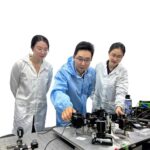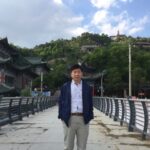 Nana Liu is an associate professor and PI of the Quantum Information and Technologies (QIT) group in the Institute of Natural Sciences at Shanghai Jiao Tong University and the University of Michigan-Shanghai Jiao Tong University Joint Institute. She received her PhD from the University of Oxford as a Clarendon Scholar and was a Postdoctoral Research Fellow at the Center for Quantum Technologies in the National University of Singapore and the Singapore University of Technology and Design. She is the 2019 recipient of the MIT Technology Review’s 10 Innovators under 35 in the Asia-Pacific region. Her current research interests include quantum algorithms for scientific computing and quantum protocols relevant for a future quantum internet.
Nana Liu is an associate professor and PI of the Quantum Information and Technologies (QIT) group in the Institute of Natural Sciences at Shanghai Jiao Tong University and the University of Michigan-Shanghai Jiao Tong University Joint Institute. She received her PhD from the University of Oxford as a Clarendon Scholar and was a Postdoctoral Research Fellow at the Center for Quantum Technologies in the National University of Singapore and the Singapore University of Technology and Design. She is the 2019 recipient of the MIT Technology Review’s 10 Innovators under 35 in the Asia-Pacific region. Her current research interests include quantum algorithms for scientific computing and quantum protocols relevant for a future quantum internet.
What is the focus of your research at the moment?
For the past two years, one my of main new research focuses has been on new methods for simulating ordinary and partial differential equations on quantum devices. These differential equations form the bedrock of almost all laws of physics, as well many applications to chemistry, biology and economics. Schrodinger’s equation, which is the foundation of quantum mechanics, is one such partial differential equation that quantum simulation was originally proposed to deal with, in particular for large dimensional problems. The question is, can quantum simulation also be helpful for other differential equations?
The answer we have found is yes, and to make this possible, we need a formalism to map any differential equation onto Schrodinger’s equations. We found that this is possible with the addition of only one extra spatial dimension and we call this method Schrodingerisation. It can be suitable for both nearer-term devices as well as large scale fault-tolerant quantum devices when they become available.
Schrodingerisation is one example in our general philosophy of finding new mathematical mappings that make our problem simpler by making small increases to dimensionality, which we can then put into a quantum device that can deal better with larger dimensions than classical devices. Apart from Schrodingerisation, we also have methods for turning uncertain problems into deterministic ones, nonlinear problems into linear ones and time-dependent problems into time-independent ones, all by adding a small number of dimensions to the original problem.
What do you consider to be the biggest advancement in quantum science to date?
Wow, that’s a hard question! That’s a really personal question I think and depends on what you care about. For me, all our understanding (about anything) is concerned with the arrangement of information. Yet information lives in physical matter and cannot be considered distinctly from physical laws that them. Landauer’s shorthand is `information is physical’. That’s what deeply attracts me to quantum information and computation and why I came into this field. There are of course so many more recent exciting developments, but I’ll stick with the oldies but goldies: quantum cryptographic protocols with quantum teleportation and quantum subroutines like phase estimation and Grover’s.
In your opinion, what could be the next big breakthrough for the field of quantum science and technology?
That’s the wonderful thing about breakthroughs, is that they are usually very surprising and unpredictable! Especially for theoretical developments, this is very hard to say because the really cool ones often come from asking questions in a very different way, with different underlying assumptions, so we might not even know these questions yet. For technological advancements, the questions might be there, but engineering difficulties might be colossal. Certainly a technological breakthrough most of us hope to see is a convincing pathway to large-scale fault-tolerant quantum computation, that is not too far into the future. We also hope for novel quantum algorithms for problems of societal interest that have substantial quantum advantage, and is not just some variation of phase estimation or amplitude amplification. This is a long-winded way to say I have no idea what will happen, but I like to keep open-minded and be joyfully surprised when breakthroughs come, no matter what forms they may take.
What role does the journal Quantum Science and Technology play in supporting research in the field?
I think QST serves an important role in the current quantum information and computation community, as the community evolves from a mostly theoretical focus to one that has genuine hope for quantum technologies becoming something tangible. Of course, at this early stage, theory and technology must move hand in hand and try to positively influence each other to make useful quantum technologies a reality. There are still a lot of theoretical developments – new protocols, new tools, new insights – necessary before we can reach this stage and QST is a perfect platform for this kind of work. There are not so many other journals that cater to this balance.
If you would like to mention any other insights we might have missed, please feel free to add that in.
Quantum research is evolving so rapidly, yet in some ways it is still rooted in some older traditions that might not fit so well the changing landscape. For example, while the theoretical computer science perspective in quantum computation rightfully dominated before we considered quantum computation as a potential technology, once we are in the realm of seeking technologically important algorithms, the scientific computing mindset should instead dominate. Otherwise, this hampers progress. However, this transition process is slow in the community, since people have been brought up to think in that particular way. One way to speed things up is to promote a more interdisciplinary perspective, which has not been so easy since the quantum information and computation community is actually relatively small. Given that it is already 30 years after Shor’s algorithm and no algorithm yet still truly rivals this one (can be argued, but not too much I think), it’s time to rethink about our approach and to welcome different opinions from different fields so we can make interesting progress.
 Professor Kihwan Kim is a tenured professor at the Physics Department of Tsinghua University. He received his bachelor’s, master’s, and doctoral degrees from Seoul National University. He then did postdoctoral work at the University of Innsbruck and the University of Maryland. Since joining Tsinghua University in 2011, he has pursued the development of quantum computation and quantum information science using trapped ions. He also raised many talented students, and under his guidance, more than 10 students have already received doctoral degrees and been pursuing their research careers.
Professor Kihwan Kim is a tenured professor at the Physics Department of Tsinghua University. He received his bachelor’s, master’s, and doctoral degrees from Seoul National University. He then did postdoctoral work at the University of Innsbruck and the University of Maryland. Since joining Tsinghua University in 2011, he has pursued the development of quantum computation and quantum information science using trapped ions. He also raised many talented students, and under his guidance, more than 10 students have already received doctoral degrees and been pursuing their research careers. Gyu-Boong Jo is a professor of Physics at The Hong Kong University of Science and Technology (HKUST). His research primarily focuses on quantum simulation with atoms, specifically exploring unconventional quantum many-body systems. He is also involved in developing a programmable quantum simulation platform for quantum information processing using neutral atoms. Before joining HKUST, Gyu-Boong earned his Ph.D at MIT in 2010, followed by postdoctoroal training at the UC Berkeley.
Gyu-Boong Jo is a professor of Physics at The Hong Kong University of Science and Technology (HKUST). His research primarily focuses on quantum simulation with atoms, specifically exploring unconventional quantum many-body systems. He is also involved in developing a programmable quantum simulation platform for quantum information processing using neutral atoms. Before joining HKUST, Gyu-Boong earned his Ph.D at MIT in 2010, followed by postdoctoroal training at the UC Berkeley. Chao-Yang Lu was born in December 1982 in Zhejiang, China. He obtained Bachelor’s degree from the University of Science and Technology of China (USTC) in 2004, and PhD in Physics from the Cavendish Laboratory, University of Cambridge in 2011. Since 2011, he is a Professor of Physics at USTC. His current research interest includes quantum computation, solid-state quantum photonics, multiparticle entanglement, quantum teleportation, superconducting circuits, and atomic arrays. His work on quantum teleportation was selected as by Physics World as “Breakthrough of the Year”. His work on single-photon sources and optical quantum computing was selected by Optical Society of American (OSA) as one of “Optics in 2016”, “Optics in 2017”, “Optics in 2019”, and “Optics in 2021”. His work on photonic quantum computational advantage was selected by APS Physics as “Highlight of the Year”, “A year of quantum highlights” by Physics World, and “World’s top 10 digital innovation technologies” by UNESCO. His work on refuting real-number formulation of quantum mechanics was selected by APS Physics as “Highlight of the Year”. He has been awarded as Fellow of Churchill College (2011), Hong Kong Qiu Shi Outstanding Young Scholars (2014), National Science Fund for Distinguished Young Scholars (2015), Nature’s top ten “science star of China” (2016), OSA Fellow (2017), Fresnel Prize from the European Physical Society (2017), AAAS Newcomb Cleveland Prize (2018), Huangkun Prize from Chinese Physical Society (2019), Nishina Asian Award (2019), Xplorer Prize (2019), IUPAP-ICO Young Scientist Prize in Optics (2019), OSA Adolph Lomb Medal (2020), APS Rolf Landauer and Charles H. Bennett Award in Quantum Computing (2021), World Economic Forum Young Global Leader (2021), James P. Gordon Memorial Speakership (2021), Achievement in Asia Award from OCPA (2022), He Liang He Li Science and Technology Innovation Award (2023), and New Cornerstone Investigator (2023). He is the Chair of Quantum 2020 and 2022 conferences. He is a Divisional Associate Editor of Physical Review Letters, and has served as an editorial board member in international journals such as Applied Physics Reviews, Quantum Science and Technology, ACS Photonics, PhotoniX, Advanced Photonics, Advanced Quantum Technology, Science Bulletin, and iScience.
Chao-Yang Lu was born in December 1982 in Zhejiang, China. He obtained Bachelor’s degree from the University of Science and Technology of China (USTC) in 2004, and PhD in Physics from the Cavendish Laboratory, University of Cambridge in 2011. Since 2011, he is a Professor of Physics at USTC. His current research interest includes quantum computation, solid-state quantum photonics, multiparticle entanglement, quantum teleportation, superconducting circuits, and atomic arrays. His work on quantum teleportation was selected as by Physics World as “Breakthrough of the Year”. His work on single-photon sources and optical quantum computing was selected by Optical Society of American (OSA) as one of “Optics in 2016”, “Optics in 2017”, “Optics in 2019”, and “Optics in 2021”. His work on photonic quantum computational advantage was selected by APS Physics as “Highlight of the Year”, “A year of quantum highlights” by Physics World, and “World’s top 10 digital innovation technologies” by UNESCO. His work on refuting real-number formulation of quantum mechanics was selected by APS Physics as “Highlight of the Year”. He has been awarded as Fellow of Churchill College (2011), Hong Kong Qiu Shi Outstanding Young Scholars (2014), National Science Fund for Distinguished Young Scholars (2015), Nature’s top ten “science star of China” (2016), OSA Fellow (2017), Fresnel Prize from the European Physical Society (2017), AAAS Newcomb Cleveland Prize (2018), Huangkun Prize from Chinese Physical Society (2019), Nishina Asian Award (2019), Xplorer Prize (2019), IUPAP-ICO Young Scientist Prize in Optics (2019), OSA Adolph Lomb Medal (2020), APS Rolf Landauer and Charles H. Bennett Award in Quantum Computing (2021), World Economic Forum Young Global Leader (2021), James P. Gordon Memorial Speakership (2021), Achievement in Asia Award from OCPA (2022), He Liang He Li Science and Technology Innovation Award (2023), and New Cornerstone Investigator (2023). He is the Chair of Quantum 2020 and 2022 conferences. He is a Divisional Associate Editor of Physical Review Letters, and has served as an editorial board member in international journals such as Applied Physics Reviews, Quantum Science and Technology, ACS Photonics, PhotoniX, Advanced Photonics, Advanced Quantum Technology, Science Bulletin, and iScience. Dr. Dong was born in 1969 at Dalian, China. He received his Ph.D. at Institute of High Energy Physics, Chinese Academy of Sciences, China, in 1999. After that, Dr. Dong joined the Physical Theoretical Chemistry Laboratory of University of Oxford as a Visiting Professor, Kansas State University as Postdoc Fellow, the National Autonomous University of Mexico as a Visiting Professor, the Mexican Institute of Petroleum as Postdoc Fellow and Distinguished Visiting Professor, and the Superior School of Physics and Mathematics, National Polytechnic Institute (IPN) as full-time Professor through the program of excellent position, and he has a permanent position as Professor at IPN since 2007. He is the Regular Member of Mexican Academy of Sciences since 2012 and Visiting Professor at Louisiana State University in 2013. Dr. Dong was awarded the certificate by Pakistan president Mamnoon Hussain at 41th International Nathiagali Summer College in 2016. He received the maximum top prize “Presea Lazaro Cardenas” and was awarded by Mexico President Lic. Enrique Peña Nieto in President Palace in 2017.
Dr. Dong was born in 1969 at Dalian, China. He received his Ph.D. at Institute of High Energy Physics, Chinese Academy of Sciences, China, in 1999. After that, Dr. Dong joined the Physical Theoretical Chemistry Laboratory of University of Oxford as a Visiting Professor, Kansas State University as Postdoc Fellow, the National Autonomous University of Mexico as a Visiting Professor, the Mexican Institute of Petroleum as Postdoc Fellow and Distinguished Visiting Professor, and the Superior School of Physics and Mathematics, National Polytechnic Institute (IPN) as full-time Professor through the program of excellent position, and he has a permanent position as Professor at IPN since 2007. He is the Regular Member of Mexican Academy of Sciences since 2012 and Visiting Professor at Louisiana State University in 2013. Dr. Dong was awarded the certificate by Pakistan president Mamnoon Hussain at 41th International Nathiagali Summer College in 2016. He received the maximum top prize “Presea Lazaro Cardenas” and was awarded by Mexico President Lic. Enrique Peña Nieto in President Palace in 2017. Qin Li received her Bachelor degree and PhD degree both in Computer Science from Hunan Normal University, China in 2005 and Sun Yat-sen University, China in 2010, respectively. Since 2010, she been at Xiangtan University, China and become a professor in 2019. Prof. Qin Li has published more than fifty technical papers on quantum computation and quantum cryptography. At present her research interests are secure delated quantum computation, quantum algorithm, and quantum artificial intelligence.
Qin Li received her Bachelor degree and PhD degree both in Computer Science from Hunan Normal University, China in 2005 and Sun Yat-sen University, China in 2010, respectively. Since 2010, she been at Xiangtan University, China and become a professor in 2019. Prof. Qin Li has published more than fifty technical papers on quantum computation and quantum cryptography. At present her research interests are secure delated quantum computation, quantum algorithm, and quantum artificial intelligence. Ming-Xing Luo is a full professor at Southwest Jiaotong University, China. He focuses on quantum information, quantum networks, and quantum batteries. He has published more than 100 academic papers in prestigious international journals, including Rep. Prog. Phys., Phys. Rev. Lett., Cell Rep. Phys. Sci., and npj Quantum Inf. He has been the recipient of National Science Funds for his ground-breaking research.
Ming-Xing Luo is a full professor at Southwest Jiaotong University, China. He focuses on quantum information, quantum networks, and quantum batteries. He has published more than 100 academic papers in prestigious international journals, including Rep. Prog. Phys., Phys. Rev. Lett., Cell Rep. Phys. Sci., and npj Quantum Inf. He has been the recipient of National Science Funds for his ground-breaking research. Lei Wang got his Bachelor’s degree from Nanjing University in 2006 and Ph.D. from the Institute of Physics, Chinese Academy of Sciences in 2011. He did postdoctoral research on computational quantum physics at ETH Zurich in the next few years. Lei Wang joined the Institute of Physics in 2016. His research interest is at the cross-section of machine learning and quantum many-body computation.
Lei Wang got his Bachelor’s degree from Nanjing University in 2006 and Ph.D. from the Institute of Physics, Chinese Academy of Sciences in 2011. He did postdoctoral research on computational quantum physics at ETH Zurich in the next few years. Lei Wang joined the Institute of Physics in 2016. His research interest is at the cross-section of machine learning and quantum many-body computation.